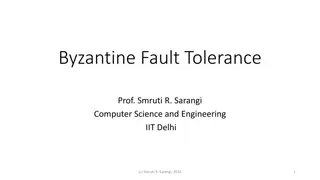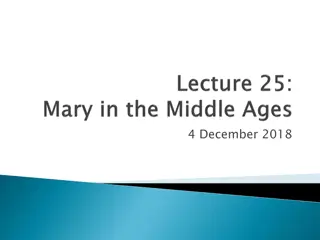Round-Efficient Byzantine Broadcast Under Strongly Adaptive and Majority Corruptions
This paper discusses a round-efficient Byzantine broadcast protocol that addresses strong adaptive adversaries and majority corruptions. The protocol involves unique and unbreakable peer signatures, committees for message verification, and time-locking mechanisms to prevent message tampering. By utilizing computational puzzles and random committee selection, the protocol ensures secure message transmission even in the presence of malicious actors. Overall, the approach offers a robust solution to the challenges posed by Byzantine fault tolerance in distributed systems.
Download Presentation

Please find below an Image/Link to download the presentation.
The content on the website is provided AS IS for your information and personal use only. It may not be sold, licensed, or shared on other websites without obtaining consent from the author.If you encounter any issues during the download, it is possible that the publisher has removed the file from their server.
You are allowed to download the files provided on this website for personal or commercial use, subject to the condition that they are used lawfully. All files are the property of their respective owners.
The content on the website is provided AS IS for your information and personal use only. It may not be sold, licensed, or shared on other websites without obtaining consent from the author.
E N D
Presentation Transcript
ROUND-EFFICIENT BYZANTINE BROADCAST UNDER STRONGLY ADAPTIVE AND MAJORITY CORRUPTIONS Authors: Jun Wa, Hanshen Xiao, Srinivas Devadas, Elaine Shi Presented By: Kendric Hood
Notation Weak adaptive adversary: can view message sent then make corruption decisions Strong adaptive adversary: can do after the fact remove of messages sent in the same round Peers have unique and unbreakable signatures (no sybil attack)
Chan et al. Broadcast under Byzantine majority A subset of peers are selected into two committees (vote 0-committee or vote 1-committee) This election is done at random so the adversary can not know who is in which committee until that peer reveals it (votes) A peer's membership can be vivified with a given verifiable random value The sender will broadcast its message If it is 0 then 0-committee will vote for it and 1-committee will not and visa versa An adversary would have to corrupt most of both committees to prevent this or trick peers listening Sense committee membership is random the adversary would have to guess at membership (unlikely)
The problem The main issue with Chan et al. is that if the adversary can do after the fact removal then it s stagy is clear. Wait for a peer to vote, corrupt it, change its vote The adversary can only change messages sent in the same round as the corruption Jun Wan address this issue directly
Solution time locking Jun Wan et al purpose a method of time locking each message with a computational difficult puzzle (think PoW) Each committee member locks their random value (committee membership) and vote into a puzzle that takes at least one round to solve. This in effect restricts the adversary to a weaker one without after the fact removal Solving all puzzles A peer can not solve all puzzles by itself (does not scale each peer would have to have parallelism in the same scale as the network) Peers solve puzzles and share solutions (just as in PoWsolutions can not be faked) Takes a polylogarithmic number of rounds (called epic) to complete broadcast























